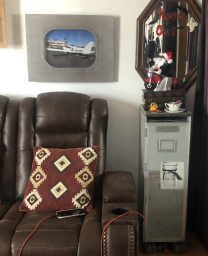
Teaching is learner-centered if . . .
- it engages students in the hard and messy work of learning
The problem: teachers are doing too many learning tasks for students - too much teaching is telling, rather than students doing
The solution: students should be asking more questions than teachers - students should be doing the summaries and reviews
- students are being taught learning skills explicitly
The problem: learning the content is more important than learning skills - teachers assume that learning skills are acquired by osmosis
The solution: facing problems that students cannot solve - assignments that get students doing the reading at the same time they develop reading skills
- students are given some control over learning processes
The problem: teachers are making all the decisions about learning for students
The solution: giving students some choice over what and how they learn - letting students decide the weight of some assignments
- students are reflecting (thinking about) what and how they are learning
The problem: students do not know much about leaning generally - students have not encountered themselves as learners
The solution: talk about learning - exam debriefs where students face the decisions made about learning
- students and teachers are learning from and with each other
The problem: teachers underestimate how much and how well students can learn from each others - teachers have concerns about using group work
The solution: collaboration on exams
META ANALYSES SHOWS THAT:
1. The lecture-only approach is the best method for transfer of information to students - FALSE
2. Students in courses that are lecture-only score better on examinations than students in courses that combine lecture and active learning activities - FALSE
3. Students in courses that are lecture-only fail more often than students in courses that combine lecture and active learning activities - TRUE
4. Students in courses that use discussion outperform the critical thinking of students in courses that are solely based on lecture - TRUE
5. Students who participate in courses with collaborative learning have greater gains in higher order skills such as critical thinking and problem solving than students in lecture only courses - TRUE
6. Students who participate in games score better on examinations than students who only have lectures - FALSE
PLANNING FOR INSTRUCTION
What are instructional methods?
Instructional methods are ways that information is presented to students.
Such methods fall into 2 categories: teacher-centered approaches and student-centered approaches.
There is not one best approach to instruction.
Some goals are better suited to teacher-centered approaches while others clearly need student-centered approaches.
Teacher-centered instruction has been criticized as ineffective and grounded in behaviorism - however this is not the case if delivered effectively.
Teacher-centered Approaches
Include instruction where the teacher's role is to present the information that is to be learned and to direct the learning process of students.
The teacher identifies the lesson objectives and takes the primary responsibility for guiding the instruction by explanation of the information and modeling.
This is followed by student practice.
Methods that fall into the teacher-centered approaches include demonstration, direct instruction, lecture and lecture-discussions.
- Demonstration: involves the teacher showing students a process or procedure such as a science process, a cooking procedure or a computer procedure. Involving students in demonstrations allow this method to be less passive.
- Direct instruction: used to help students learn concepts and skills. There are various models of direct instruction but all include similar steps:
1. intro and review
2. presentation of new information
3. guided practice
4. independent practice
- Lecture: the most criticized of all teaching methods AND the most commonly used because:
1. planning time is limited
2. lectures are flexible and can be applied to any content
3. lectures are simple
The most critical fact about lecture is that it puts students in a passive role.
- Lecture-discussions: combinaiton of lecture and teacher questioning of students.
Learner-centered Approaches
Grounded in constructivism, learner-centered approaches involve instruction where the teacher is a facilitator (or guide) as the learners construct their own understandings.
There are a number of methods in this category that are listed and explained below.
- Case studies: involve groups of students working together to analyze a "case" that has been written on a particular situation or problem to find a solution.
Case studies allow students to apply new knowledge and skills for solving complex issues.
This method is not appropriate for use with elementary students.
The case study is completed by discussion of the case, allowing learners to debate their conclusions.
- Cooperative learning: involves small heterogeneous student groups working together to solve a problem or complete a task.
All students in the group must actively participate with each student maintaining some independence.
The success of the group depends on the input of each individual.
This teaching method promotes active participation, individual accountability, students' ability to work cooperatively and improvement of social skills.
- Discussion/Discussion boards: designed to encourage thinking skills, discussion allows learners to increase interpersonal skills.
Discussions may occur in the classroom or online.
One way to implement discussions with twenty-first century students is to use discussion boards.
Previously referred to as "bulletin boards" or "message boards" these areas are places where a question can be posted by the teacher and students may post "threads" (comments to the question) asynchronously (at various times).
Discussion boards vary in participation and good discussion may result from the expertise of the facilitator.
Incentives (bonus points) may be needed to motivate all students and rules must be made clear.
- Discovery learning: an inquiry-based learning method in which learners use prior knowledge and experience to discover new information that they use to construct learning.
This method is the most successful if the student has some prerequisite knowledge and the experience is structured.
- Graphic organizers: found in the form of diagrams, maps and webs and illustrate information in a graphical format.
Diagrams may be drawn by hand or designed on the computer with programs such as Inspiration.
This strategy/tool can be used when brainstorming ideas, analyzing stories, analyzing characters, comparing and contrasting information, storyboarding (planning projects) prewriting during the writing process and breaking down concepts to show the relationships with parts (such as the parts of a cell).
These graphical representations have been found to make information easier to learn and understand, especially complex information.
Further, using visual learning strategies have been found to be effective with struggling learners.
- Journals/blogs: journals are often used in classrooms to allow students to record reflections and ideas.
Typically written in a notebook and recorded each day, the journal serves as a method of communicaiton between the student and the teacher.
A blog is short foro web log and is simply an online journal or diary versus its more traditional "notebook" cousin.
A new method for reflective writing, blogs can be used to share ideas and/or thoughts on various subjects.
These reflections and ideas may be private or public.
Blogs are considered great motivators for student writing and offer a novel way for students to engage in refleective writing and sharing information on classroom topics.
- K-W-L: Know - What to know - Learned
Strategy that is typically used to provide structure to the learning process to allow students to recall what they know about a topic, what they want to know about the topic, and what is to be learned.
This strategy allows students to become actively involved in theor learning.
Generally, a chart is created on the board, overhead or hand-out.
Students fill in the KNOW column before they begin their study.
The fill in the WANT TO KNOW column with all of the information that they want to learn about the topic.
After the study, they complete the LEARNED column with their new knowledge.
- Learning Centers: Self-contained areas where students work independently or with small groups (pairs or triads) to complete a task.
Centers may take the form of chairs placed around a table for group discussion, display boards that present questions/problems/worksheets. or computer/computers where students perform hands-on activities or research on the web.
- Role-play: deals with solving problems through action.
A problem is identified, acted out and discussed.
The role-play process provides students with an opportunity to:
1. explore their feelings
2. gain insight about their attitudes
3. increase problem solving skills
- Scaffolding: involves the teacher modeling the skill and thinking for the student.
As the student increases understanding, the teacher withdraws the assistance allowing the student to take on more responsibility for the learning.
- Problem-based learning (PBL) and Inquiry learning: involves teacher giving the student a problem where inquiry must be utilized to solve the problem.
There are commonly four steps in this model:
1. student receives the problem
2. student gathers data
3. student organizes data and attempts an explanation to the problem
4. students analyze the strategies they used to solve the problem
A well known and highly successful inquiry-based strategy is WebQuests.
- Simulations: used to put the student in a "real" situation without taking the risks.
Simulations are meant to be as realistic as possible where students are able to experience consequences of their behavior and decisions.
Simulations are commonly used in social studies and science but can be used in other curriculum areas.
Computer simulations are quite common in today's virtual world, e.g. "dissecting a frog" using the computer.
- Storytelling/ Digital storytelling: A great way to strengthen communication skills is to get students involved in creating multimedia stories.
Topics can range from biographical stories with photo collections from family archives to community mapping projects, virtual field trips within the community, or more complex stories created by older students.
These digital stories can be planned, storyboarded and produced using slideshow software such as PowerPoint or video editing software such as IMovie.
This strategy has become quite the rage in recent years with students loving the active learning.
7 Principles for LCT Instructors
1. Teachers let students do more learning tasks.
2. Teachers do less telling so that students can do more discovering.
3. Teachers do instructional design work more carefully.
4. Faculty more explicitly model how experts learn.
5. Faculty encourage students to learn from and with each other.
6. Faculty and students work to create climates for learning.
7. Faculty use evaluation to promote learning.
|
TEACHER-CENTERED
|
LEARNER-CENTERED |
|
Focus is on instructor |
Focus is on both students and instructor |
|
Focus is on language forms and structures (what the instructor knows about the language) |
Focus is on language use in typical situations (how students will use the language) |
|
Instructor talks – students listen |
Instructor models – students interact with instructor and one another |
|
Students work alone |
Students work in pairs, in groups, or alone depending on the purpose of the activity |
|
Instructor monitors and corrects every student utterance |
Students talk without constant instructor monitoring – instructor provides feedback/correction when questions arise |
|
Instructor answers students’ questions about language |
Students answer each other’s questions, using instructor as an information resource |
|
Instructor chooses topics |
Students have some choice of topics |
|
Instructor evaluates student learning |
Students evaluate their own learning – instructor also evaluates |
|
Classroom is quiet |
Classroom is often noisy and busy |
Primary Characteristics of Learner-Centered Teaching
1. Learner-centered teaching engages students in the hard, messy work of learning.
2. Learner-centered teaching includes explicit skill instruction.
3. Learner-centered teaching encourages students to reflect on what they are learning and how they are learning it.
4. Learner-centered teaching motivates students by giving them some control over learning processes.
5. Learner-centered teaching encourages collaboration
"This process is designed so htat students can learn how they learn best. Taking into consideration what works for one may not work for another and at the end of the day it is not about what was taught but what was learned." - Varrata, 2017
Contact Me
Sarah Nilsson, J.D., Ph.D., MAS
602 561 8665
You can also fill out my
Get Social with Me
Legal Disclaimer
The information on this website is for EDUCATIONAL purposes only and DOES NOT constitute legal advice.
While the author of this website is an attorney, she is not YOUR attorney, nor are you her client, until you enter into a written agreement with Nilsson Law, PLLC to provide legal services.
In no event shall Sarah Nilsson be liable for any special, indirect, or consequential damages relating to this material, for any use of this website, or for any other hyperlinked website.
Steward of
I endorse the following products
KENNON (sun shields)








